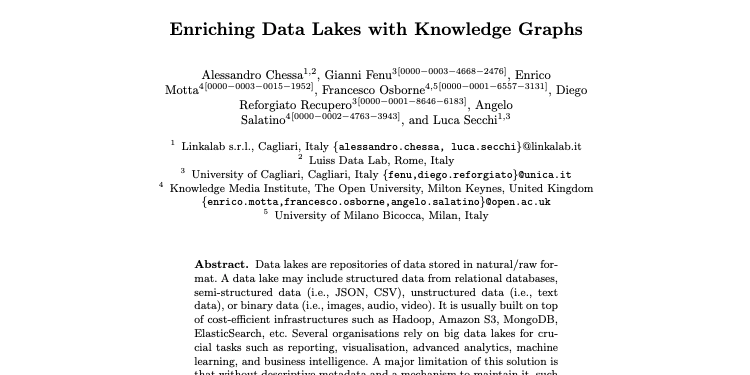“Enriching Data Lakes with Knowledge Graphs” is a workshop paper published at “Knowledge Graph Generation from Text” co-located with ESWC 2022.
Alessandro Chessa1,2, Gianni Fenu3, Enrico Motta4, Francesco Osborne4,5, Diego Reforgiato Recupero3,Angelo Antonio Salatino4, Luca Secchi1
1 Linkalab s.r.l., Cagliari, Italy
2 Luiss Data Lab, Rome, Italy
3 University of Cagliari, Cagliari, Italy
4 Knowledge Media Institute, The Open University, Milton Keynes, United Kingdom
5 University of Milano Bicocca, Milan, Italy
Abstract
Data lakes are repositories of data stored in natural/raw format. A data lake may include structured data from relational databases, semi-structured data (i.e., JSON, CSV), unstructured data (i.e., text data), or binary data (i.e., images, audio, video). It is usually built on top of cost-efficient infrastructures such as Hadoop, Amazon S3, MongoDB, ElasticSearch, etc. Several organisations rely on big data lakes for crucial tasks such as reporting, visualisation, advanced analytics, machine learning, and business intelligence. A major limitation of this solution is that without descriptive metadata and a mechanism to maintain it, such data tend to be noisy, making their management and analysis complex and time-consuming. Therefore, there is the need to add a semantic layer based on a formal ontology to describe the data and efficient mechanism to represent them as a knowledge graph. In this paper, we present a methodology to add a semantic layer to a data lake and thus obtain a knowledge graph that can support structured queries and advanced data exploration. We describe a practical implementation of a methodology applied to a data lake consisting of text data describing the online marketplace for lodging and tourism activities. We report statistics about the data lake and the resulting knowledge graph.
Download
Link will be available soon



